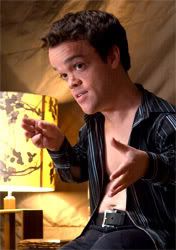 Over at the Premiere website, which is sadly all that’s left of that estimable magazine, Glenn Kenny blogs about a strange phenomenon sweeping through the critical community.
Over at the Premiere website, which is sadly all that’s left of that estimable magazine, Glenn Kenny blogs about a strange phenomenon sweeping through the critical community.
A number of reviews of Martin McDonough’s “In Bruges” are making special mention of Peter Dinklage’s appearance as a cranky actor whose acquaintance is made by Brendan Gleeson and Colin Farrell over the course of the film.
There’s just one problem: That’s not Peter Dinklage. It’s Jordan Prentice, an entirely different actor who also, um, happens to be a dwarf.
Some people will rush to pin the confusion on an unconscious bias in the critics’ minds — you know, “all little people look alike” to them, and so on — but I think the confusion is the movie’s fault.
“In Bruges” is a pretty derivative film. Most of it is cribbed from the works of Quentin Tarantino and Neil Jordan — the jabbering hitmen are from “Pulp Fiction”, and the incident that gets them exiled from London has echoes of “The Crying Game” to me, and there’s also the issue of Gleeson more or less playing the same character he played in Paddy Breathnach’s little-seen Irish gangster picture “I Went Down” — but McDonough has also lifted a key chunk of material from Tom DiCillo’s “Living in Oblivion”.
That would be the bit with the dream sequence featuring a dwarf, who eventually explodes at his director with a brilliant rant about all the cliches of dwarves and dream sequences. (“Have you ever hard a dream with a dwarf in it? Do you know anyone who’s had a dream with a dwarf in it? I don’t even have dreams with dwarves in them!”)
And the dwarf in that film is played by Peter Dinklage.
Maybe it’s just that simple. Maybe the critics who’ve confused Prentice — who’s very good in “In Bruges”, albeit in a thankless role — with Dinklage are just allowing themselves to be led astray by the movie’s second-hand aesthetic. Who else could that be, in the Dinklage role from “Living in Oblivion”, but Dinklage himself?
Of course, this also presumes those critics have seen “Living in Oblivion”, which isn’t a safe bet … and it also means they didn’t check the credits or bother with the press notes, which ain’t exactly the best way to get one’s facts straight.
I gotta say, though, I can see how this sort of mistake could be made while dashing off a quick review: To my everlasting shame, I once identified Tom Sizemore as Michael Madsen in a review of “Heat”, despite having previously met and interviewed both actors … and despite liking one a lot more than the other.
In my defense, though, those guys really do look alike.
They made that same mistake on At the Movies with Ebert and Roeper this past weekend. The guest co-host (can’t remember his name, but I liked him) said it was Dinklage.
I dunno, Norm, I think you’re giving our brethren way too much credit here. It’s just good old-fashioned ignorance.
I get Madsen and Sizemore confused all the time.
Actually, Michael Phillips (guest-hosting Ebert & Roeper) correctly identifies Dinklage in “Penelope”, not “In Bruges”.